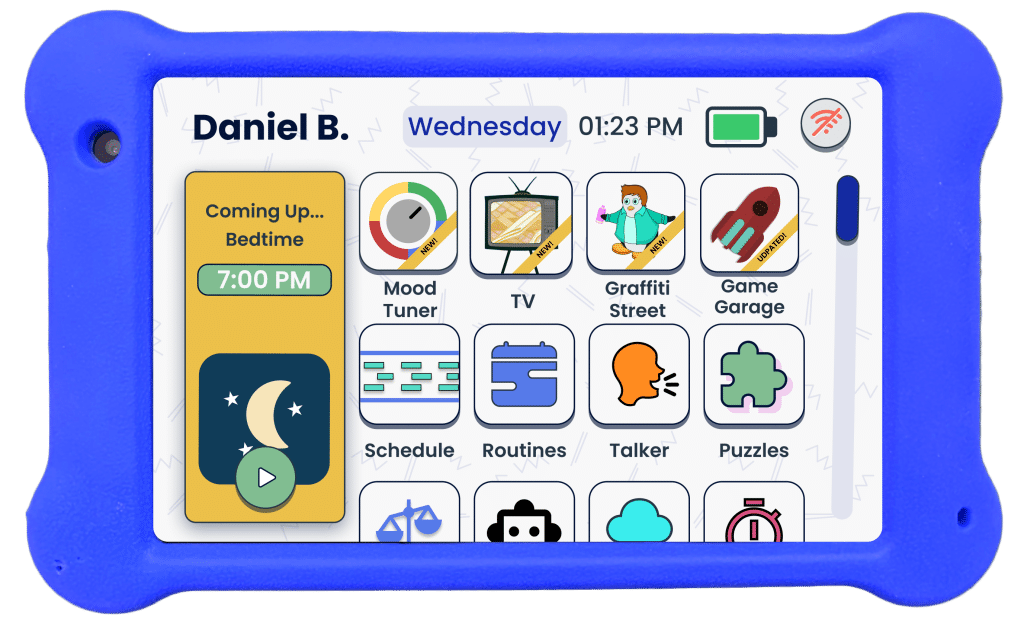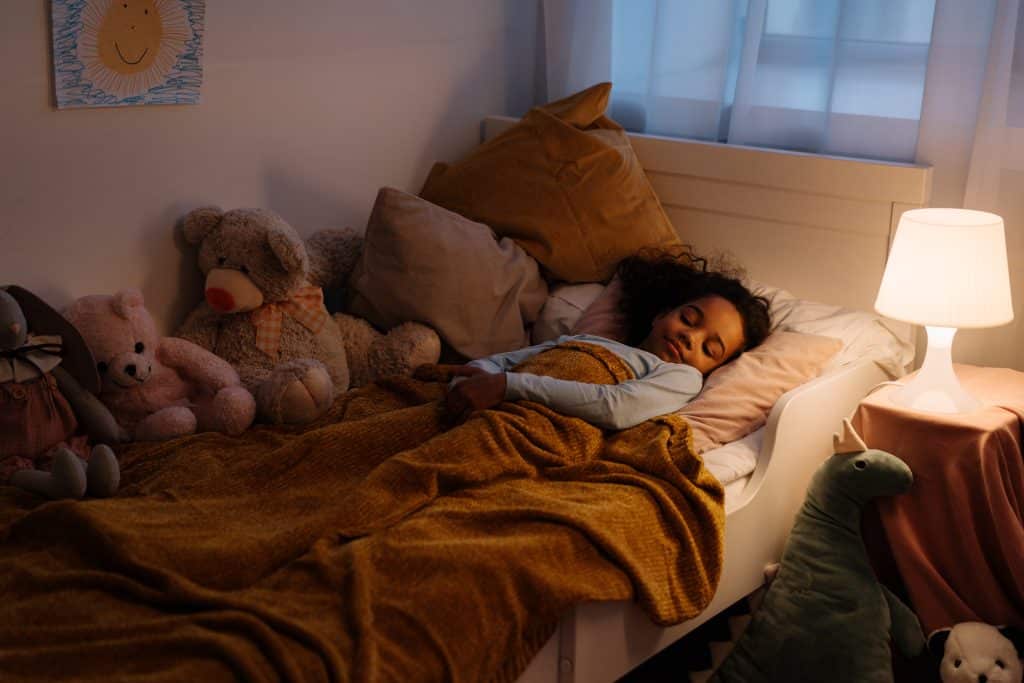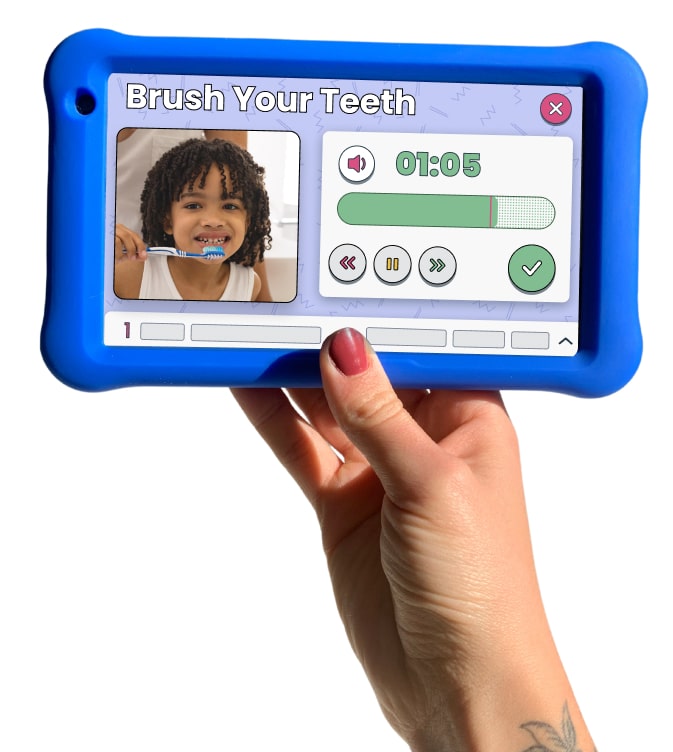Bedtime routines can be one of the most stressful times of day, especially for an autistic child. It can be filled with tears, screams, sleepless nights, and restless mornings. However, by setting some consistent habits, you and your child with autism could have a more peaceful schedule for autistic child. This in turn will allow for more positive moments together.
Table of Contents
Preparing for Bedtime
The most important time to address bedtime issues or problems is oddly before bedtime. By preparing for the bedtime routine ahead of time, you are setting your child with autism up for success and avoiding any potential problems before they arise. Autistic children also thrive and respond well to schedules, consistency, and knowing what’s to come. You can provide your child with these comforts by creating a bedtime routine. This should be the same every evening and begins well before bedtime.
Recommended Skill-Building Tablet for Autism:

Pro tip— Goally has an entire therapy suite of apps on a distraction-free tablet made to help autistic kiddos in daily routines. See everything included on the tablet below!
About an hour before your child’s bedtime, it’s a good idea to remove any electronics or TV. This is helpful for two reasons. First research has shown that electronics, such as iPads or video games, can disturb regular sleep patterns. This makes it difficult for them to fall asleep. Second, children often have a difficult time transitioning from electronics to something less preferred, like getting ready for bed. By removing these as options about an hour before bedtime, you’re already setting your child up for a successful bedtime. Make sure you have other activities or tasks for them to do during this time, especially if they’re used to watching TV or playing with their iPad right up until bedtime. This is also a great time to start giving verbal and visual reminders that autism bedtime routine is coming.

Read More: ADHD Child Waking Up Early? Here’s What to Do
Getting ready for bed can be made easier with the help of Goally. You can use it to create a visual schedule for autistic child that includes all the necessary tasks. For example, brushing their teeth, changing into pajamas, going to the bathroom, and reading a bedtime story. With Goally, you can track your child’s progress and reward them with points. This will help your child stay motivated and independent, and also reduce stress during bedtime for your family.
If you don’t have a Goally yet, a visual schedule of their bedtime routine will work great. Have pictures of each task your child needs to complete and set a timer for that task. If your child completes tasks within the time limit, they can earn points towards a reinforcer once they’re in bed! Be mindful that your child may need help completing some tasks, such as brushing their teeth, and that’s ok! As time goes on, you can fade out prompts using the Prompt Hierarchy to help them become more independent.
During Bedtime
Once your child is in bed, now is a great time to reward them with any reinforcements they may have earned from completing their bedtime routine in the set amount of time without any inappropriate behaviors. These may include extra books to read at bedtime, a special cozy drink in bed, or extra snuggles in bed. You and your child can come up with some ideas of what special items or activities they’d like to earn if they complete their bedtime routine without any issues!
Read More: How to Make a Bedtime Routine for an Autistic Child
Now is a great time to prepare your child’s bedroom with any environmental changes they need to help them fall asleep. Set up the night light that your child prefers, grab that water bottle to keep by their bed, or put the sound machine outside the door that helps block out any distracting noises. By preparing their room earlier, you’re lowering the chances that they will leave their bed to ask for these items.
Difficulties That May Arise During Bedtime
Bedtime can be a difficult time for children with learning differences or attention issues, especially if they have autism. One common challenge is getting them to stay in bed throughout the night. They may get up as soon as you put them to bed or wake up in the middle of the night and come to your room. In these situations, it’s important to remain calm and walk them back to bed each time. Use a neutral tone of voice and gently remind them that it’s time to sleep. Try to avoid giving them extra attention, such as extra cuddles or bedtime stories, as this could reinforce their behavior and make it more difficult to get them to stay in bed.

Read More: How to Make the Best Bedtime Routine for Kids + A Free Bedtime Routine Chart
You may have to do this over and over for a few nights, especially when you’re starting this new routine. But it is important to be consistent and calm and walk them back to bed each and every time. By doing this, you’re showing your child that you’re in control and that you are the parent. Over time, your consistency will allow your child to know exactly what to expect from you and provide a safe and comforting environment for them to fall asleep. It’s easy to try this new routine two or three nights and give up because it doesn’t work right away. But don’t fret, it takes time! Any new habit takes time, practice, and patience. You are implementing something new for you and your child, so there will be a bit of an adjustment period.
If your child continues to struggle during bedtime, it’s important to contact your doctor and rule out any medical issues. Additionally, your doctor, BCBA or other professional can help you tweak your child’s bedtime routine to fit their specific needs.
Goally | Apps for a Smooth Bedtime Routine
Ready to start using technology for your kiddo’s bedtime routine? Goally’s skill building tablet for kids has routines that break down large tasks into small, achievable steps. It helps kids complete their tasks independently and with confidence!

Create custom routines with your own videos & pictures for every step. The steps come in small, bite-sized pieces to help your child learn the little fundamentals (like putting the toothpaste on their toothbrush!) to achieve bigger goals. Setting expectations for bedtime routines helps build your kiddo’s independence in daily tasks. The best part about Goally is that it will grow with your child’s needs.
Try our distraction-free device (with ONLY Goally apps on it) for $149. And by distraction-free, we mean your kiddo won’t be sneaking onto Youtube… 😉
Autism bedtime routines should be quiet and relaxing and a time to get quality moments with your child with autism. By implementing a consistent routine each evening and following through with expectations, you can get closer to creating this type of environment for your and your child. A better night’s sleep for your child means a better night’s sleep for you and a delightful morning for everyone!
FAQs About Bedtime Schedule for Autistic Child
What is a bedtime routine and why is it important for children with special needs? A bedtime routine is a set of activities and behaviors that a child engages in before going to sleep. For children with special needs, a consistent bedtime routine can provide a sense of structure and predictability, which can help them feel more calm and secure. How can I create a successful bedtime routine for my child with special needs? To create a successful bedtime routine, it's important to establish a consistent schedule, incorporate activities that your child enjoys, and use visual aids or tools like a visual schedule or a bedtime chart to help your child understand the routine. What are some common challenges that children with special needs may face during bedtime? Children with special needs may experience a variety of challenges during bedtime, including difficulty falling or staying asleep, anxiety, sensory issues, and disruptive behaviors. How can I address disruptive behaviors during bedtime routine? To address disruptive behaviors, it's important to establish clear expectations and consequences, use positive reinforcement techniques like praise and rewards, and work with a behavioral specialist or therapist if necessary. Should I allow my child to have screen time before bedtime? It's generally recommended to avoid screen time for at least one hour before bedtime, as the blue light from electronic devices can interfere with sleep. Instead, try incorporating calming activities like reading a book or listening to soothing music.
This post was originally published on 12/28/2020. It was updated on 06/22/2023.
____________________________________________________
Mallory Giacopuzzi is a Board Certified Behavior Analyst who has over 10 years of experience serving children, adolescents, and adults with disabilities and their families in a classroom, clinic, and home setting. She is the Program Administrator for an Adult Day Program for adults with autism and other disabilities and a Case Manager for in-home ABA services.
Editor’s note: This information is not meant to diagnose or treat and should not take the place of personal consultation, as needed, with a qualified healthcare provider and/or BCBA.

Goally
We help parents teach their kids life skills, like doing bedtime and morning independently. Backed by science, we incorporate evidence-based practices and expert-informed designs in all of our apps and content.






